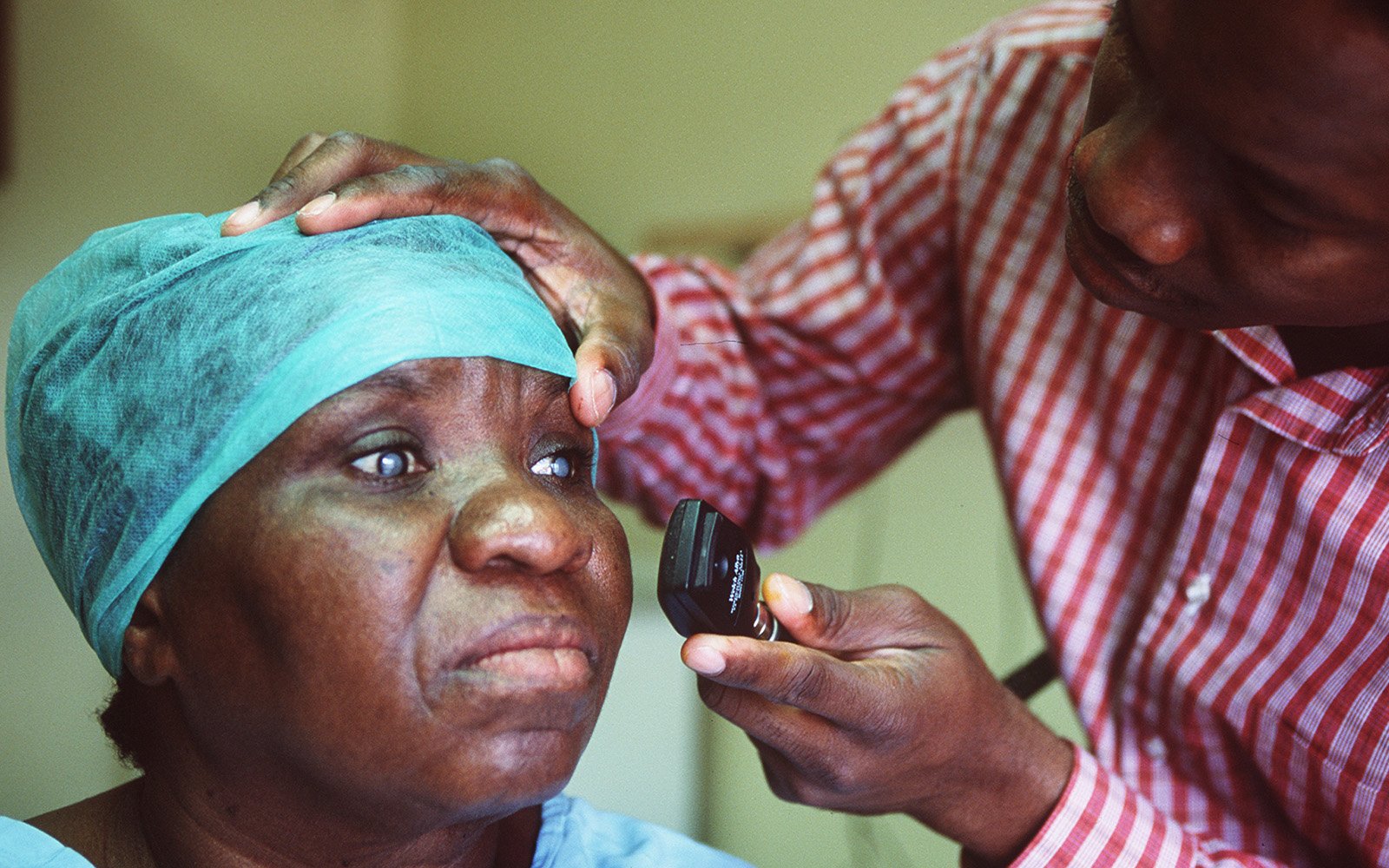Astigmatism: another refractive error caused by irregularities in the shape of the eye’s
cornea or lens. Astigmatism distorts light rays, preventing them being focused on the retina, causing vision to be blurred. Astigmatism is common and can be corrected with glasses if it causes a problem but is often well tolerated.
Age-Related Macular Degeneration: the deterioration or breakdown of retinal function at the macula. This most commonly occurs as part of ageing but is more common in those who smoke tobacco and in people with myopia. The macula is the part of the retina that is needed for sharp, central vision. Damage to the
macula causes the centre of the field of vision to appear blurred, distorted or missing.
 A woman with cataract
Cataract:
A woman with cataract
Cataract: a clouding of the normally crystal clear lens of the eye.
Cataract can affect either or both eyes. The cloudiness reduces the amount and quality of light able to enter the eye, which causes vision to become blurred and more dim. The cloudiness of the lens is due to changes to the protein structure, reducing transparency.
Cataracts are most commonly associated with increasing age but also can be caused by certain diseases (such as diabetes), eye injuries, some medications and environmental factors. If cataracts are left untreated the cloudiness continues until blindness results.
Childhood Blindness: diseases and conditions occurring in childhood that result in blindness or vision loss if left untreated. Childhood eye diseases are significantly more likely to affect children living in low and middle income countries. The major causes of
childhood blindness in such countries are corneal scarring from vitamin A deficiency (precipitated by measles or diarrhoeal diseases) cataract, injuries and retinopathy of prematurity.
Cellulitis: is tissue inflammation with redness, swelling and pain caused by bacterial infection. It can affect the eyelid or eye socket. Orbital cellulitis is a serious infection of the eye socket that can migrate backwards to the brain. Cellulitis is treated with antibiotics.
Corneal Abrasion: a scratch or cut on the surface of the
cornea, the clear front part of the eye. Corneal abrasions are generally caused by an injury to the surface of the eye. They are very painful and cause profuse watering. It’s difficult to open the eye but corneal abrasions generally heal very quickly.
Corneal Laceration: a cut on the cornea at the front of the eye. A corneal laceration is caused by injury to the eye from a sharp object. If the cut penetrates through the cornea and enters inside the eye it can cause infection and severe damage to the whole eye, with catastrophic vision loss.
Corneal Ulcer/Keratitis: caused by an infection or injury to the outer tissues of the cornea deeper than the epithelium. Corneal ulcers can result in vision impairment, pain, and scarring to the cornea and may not heal quickly.
Diabetic Retinopathy: this is a condition where the retina (back of the eye) is damaged as a result of diabetes.
Diabetic retinopathy occurs when tiny blood vessels in the retina are damaged by raised levels of sugar in the blood. These blood vessels can then bleed or leak fluid, damaging the retina (causing a retinopathy) and reducing vision.
Eye Allergies: a condition that occurs when the eyes react to an irritant (allergen), also known as allergic conjunctivitis. The eyes become red, teary, swollen and itchy. Eye allergies are usually associated with seasonal variations like high pollen counts and are often related to hay fever.
Eye Cancer: there are various forms of cancer that can affect the eyes, including eye melanoma, lymphoma, and retinoblastoma. Some eye cancers cover the surface of the eye, and others occur internally (intraocular cancers). They can both cause pain, blurred vision, or vision loss. Eye cancers can spread from the eye to other parts of the body, or can be the result of cancers in other parts of the body that have spread to the eyes.
Glaucoma: there are several types of glaucoma and most are difficult to screen for and treat, so unlike cataract, the vision impairment or blindness caused by glaucoma is less ‘avoidable’. The condition is characterised by relatively high pressure in the eye and damage to the retina and optic nerve, resulting in progressive loss of peripheral vision. Ocular hypertension where pressure inside the eyeball (intraocular pressure) is higher than normal, may predispose the patient to develop glaucoma eventually.
Hyperopia/Hypermetropia or long-sightedness: a refractive error where the eye is naturally focused in the far distance, or ‘beyond’. The natural ability of the eye to shift focus from far to near (called accommodation) usually allows long sighted people to focus closer to where they want to see clearly, but as they get older this gets harder to do and symptoms of eye strain develop. They also get presbyopia sooner and need reading glasses earlier in their life.
Myopia or short-sightedness: a refractive error that results in distant objects being blurred. The eye cannot focus properly on distant objects. It may be inherited or caused by a number of behavioural factors and also occurs from ageing changes of the lens. Myopia in young children is becoming increasingly common, particularly in Chinese populations. Its severity can be reduced by encouraging children to play out of doors for at least 90 minutes every day. Treatment is with glasses or contact lenses and sometimes with laser surgery. A high degree of myopia is associated with retinal problems, glaucoma and cataract.
Presbyopia: occurs when it becomes difficult to see close objects and most often occurs with increasing age. Commonly, reading glasses are needed after the age of 45 years and progressively need to be strengthened as the ability to focus closely (or ‘accommodate’) gets weaker.
Refractive Error: an eye disorder that occurs when the eye cannot focus clearly. This causes blurred vision or vision impairment. A refractive error occurs when the eye is shaped in such a way that light cannot be sharply focused on the retina. There are several types of refractive error, including myopia (short sight or nearsightedness) and hyperopia (long sight or farsightedness). Refractive errors can be treated with glasses, contact lenses or surgery.
Retinal Detachment: the retina normally lines the back inside surface of the eyeball. It can detach from its normal position, floating forward into the vitreous space or be pulled there by internal scar tissue. Once detached the retina fails to function and in time dies. A retinal detachment prevents the retina from working properly, and causes vision to become blurry. Retinal detachment leads to blindness if it is not urgently treated with surgery.
Strabismus: a condition in which the eyes are misaligned and point in different directions. Eyes may turn inward (esotropia), outward (exotropia), upward (hypertropia) or downward (hypotropia). Strabismus is caused by abnormalities in the eye muscles or the nerves that control these muscles and may be due to poor vision in one eye. In children it can cause poor vision or blindness, usually in one eye.
 Face washing is an important part of trachoma prevention
Trachoma:
Face washing is an important part of trachoma prevention
Trachoma: a bacterial eye infection, which inflames and scars the inner surface of the eyelids during childhood. Repeated
trachoma infections over years can cause a person’s eyelids to turn inwards from all the scarring, causing the eyelashes to rub on the clear cornea (trichiasis).The continual rubbing causes a lot of pain and inflammation of the cornea which becomes cloudy from more scarring until vision is impaired or lost. It affects women far more than men because they look after the infected children in the home.
Trichiasis: an eyelid abnormality where the eyelashes point inwards to touch the eyeball. Trichiasis can be caused by eye infections like trachoma, but is also caused by ageing and inflammation from chemical injuries to the eye.
Secondary Cataract: a condition that can occur after a sight-restoring cataract surgery, which causes clouding of the vision. Secondary cataract occurs when a replacement eye lens becomes cloudy in a similar manner to the original lens damaged by cataract. A secondary cataract is not an actual cataract, but does have similar symptoms. It can be treated easily with a laser procedure.
Uveitis: a set of inflammatory diseases affecting the various vascular structures of the eye like the iris, ciliary body and choroid (jointly referred to as the uvea). Often caused by autoimmune problems, infections, toxins or after injuries. Characterised by a painful red eye, sensitivity to light and vision loss. Treated with anti-inflammatory drugs like steroids and drops to dilate the pupils.
Vitamin A Deficiency: is a significant problem in developing countries, occurring when people, especially young children, do not have access to a balanced diet with enough vitamin A. Sources of vitamin A are: milk, eggs, liver, fish, green leafy vegetables and orange or red fruit. In infants, blindness can result from damage to the cornea after diseases like diarrhoea and measles. In adults, poor night vision is a common problem because retinal function is also affected.
Please visit our
Eye Health section for more in depth information on:
You may also like to visit our Research page for in-depth information on a variety of topics.
Disclaimer: the content on this page is not intended to be medical advice. For medical advice, please contact your local health professional.